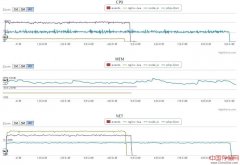本文介绍Nginx日志分析方案分享,希望对于初学Nginx服务器相关的朋友有帮助,更多Nginx安装、配置、报错处理等资源请本站内搜索。。
第一步,日志的处理。
最好每天分割一下日志,一开始没注意这个工作,结果不久日志文件就上G了,很痛苦。分割日志很简单,首先把日志文件复制到别的地方,然后再通知 nginx重新生成日志就可以了。shell脚本如下:
#!/bin/bash
logs_path="/nginx/logs/"
mv ${logs_path}access.log ${logs_path}access_$(date -d "yesterday" +"%Y%m%d").log
kill -USR1 `cat /nginx/logs/nginx.pid`
代码中的/nginx/logs指的是nginx的log日志文件所在目录,生成了以昨天日期命名的日志文件。
为了达到每天自动分割的目的,在crontab中加入以下部分:
1 0 * * * sh /home/zyf/sh/cut_nginx_log.sh
这样就每天的0点1分把nginx日志重命名为日期格式,并重新生成今天的新日志文件。
第二步,Awstats的配置。
日志文件分割好了,接下来就是分析了,也就是Awstats的使用了。
Awstats的配置文件默认会存储在/etc/awstats/目录下,包括你安装时设置的域名 如:awstats.www.xxxxke.com.conf。在这个配置文件中修改这个地方:
LogFile="/nginx/logs/access_%YYYY-24%MM-24%DD-24.log"
这个意思是要去读取nginx昨天的日志文件,关于后边%YYYY-24%MM-24%DD-24的设置,规则如下:
# You can also use tags in this filename if you need a dynamic file name# depending on date or time (Replacement is made by AWStats at the beginning
# of its execution). This is available tags :
# %YYYY-n is replaced with 4 digits year we were n hours ago
# %YY-n is replaced with 2 digits year we were n hours ago
# %MM-n is replaced with 2 digits month we were n hours ago
# %MO-n is replaced with 3 letters month we were n hours ago
# %DD-n is replaced with day we were n hours ago
# %HH-n is replaced with hour we were n hours ago
# %NS-n is replaced with number of seconds at 00:00 since 1970
# %WM-n is replaced with the week number in month (1-5)
# %Wm-n is replaced with the week number in month (0-4)
# %WY-n is replaced with the week number in year (01-52)
# %Wy-n is replaced with the week number in year (00-51)
# %DW-n is replaced with the day number in week (1-7, 1=sunday)
# use n=24 if you need (1-7, 1=monday)
# %Dw-n is replaced with the day number in week (0-6, 0=sunday)
# use n=24 if you need (0-6, 0=monday)
# Use 0 for n if you need current year, month, day, hour
第三步,开始分析、生成结果。
最后,可以执行分析了。使用这个命令: 本博客已搬家,全部内容请看这里:http://blog.goyiyo.com/archives/197第四步,自动化。
要是每天都去服务器上运行几条命令肯定是件令人烦燥的事情,所以呢,linux的世界里有crontab这样的好东东,很简单,下面是我的 crontab
1 0 * * * sh /home/zyf/sh/cut_nginx_log.sh0 1 * * * /usr/local/awstats/wwwroot/cgi-bin/awstats.pl -update -config=www.xxxxke.com0 2 * * * perl /usr/local/awstats/tools/awstats_buildstaticpages.pl -update -config=www.xxxxke.com -lang=cn -dir=/html/awstats -awstatsprog=/usr/local/awstats/wwwroot/cgi-bin/awstats.pl-------------------------------------------------------------------------
大功告成,打完收功……
LogFile="/usr/local/nginx/logs/%YYYY-24/%MM-24/expotia2.access_%YYYY-24%MM-24%DD-24.log"
log_format main '$remote_addr - $remote_user [$time_local] "$request" '
'$status $body_bytes_sent "$http_referer" '
'"$http_user_agent" "$http_x_forwarded_for"';
声明: 此文观点不代表本站立场;转载须要保留原文链接;版权疑问请联系我们。










